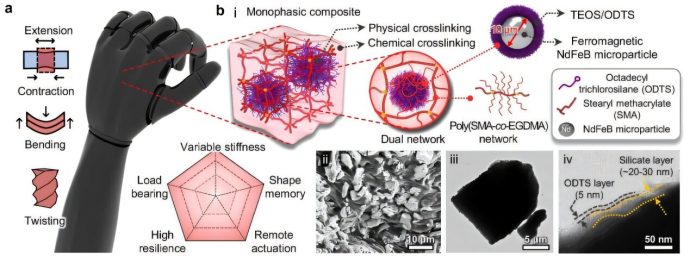
A team of researchers at UNIST, led by Professor Hoon Eui Jeong, has developed a groundbreaking artificial muscle material that can handle forces up to 1,000 times its own weight.
Published in Nature Communications, this new material combines magnetism and shape memory technology to create artificial muscles that are both strong and flexible—qualities that could transform fields like robotics, wearable tech, and medicine.
Artificial muscles are soft materials designed to mimic the smooth motion of human muscles.
While they’re excellent for flexible applications, traditional versions lack the rigidity needed to lift heavy objects or maintain stability during movement.
This means they struggle with vibrations and can’t always handle precise control, limiting their use in high-demand applications.
To address these issues, the UNIST team created a unique magnetic composite by combining two key components: ferromagnetic particles and shape memory polymers.
The ferromagnetic particles allow the artificial muscle to respond to magnetic fields, generating powerful forces, while the shape memory polymers provide rigidity when needed.
The result is a material that can switch between soft and rigid states, making it exceptionally adaptable.
Through careful design, the researchers ensured that the ferromagnetic particles tightly bond with the shape memory polymer.
This connection not only strengthens the artificial muscle but also allows it to react quickly to magnetic fields, switching from soft to hard states as needed.
In tests, the new material increased its stiffness by over 2,700 times, achieving a softness that was eight times greater when in its flexible state.
Under rigid conditions, the artificial muscle can support tensile (stretching) forces up to 1,000 times its weight and compressive forces up to 3,690 times its weight, comparable to supporting the weight of a car. It also achieved an energy efficiency of 90.9%, making it highly effective for repetitive movements.
To improve control, the team added a hydrogel layer that dampens unwanted vibrations, allowing for more precise operation, even at high speeds.
This double-layer design enables the artificial muscle to perform basic movements like bending, stretching, and twisting, as well as complex actions, such as manipulating objects.
Professor Jeong believes this innovation has the potential to impact various fields due to its unique mechanical properties.
By using techniques like laser heating and magnetic field control, these artificial muscles can be remotely directed to perform a wide range of movements, opening doors for future applications in industries requiring high strength, flexibility, and control.
Source: KSR.



